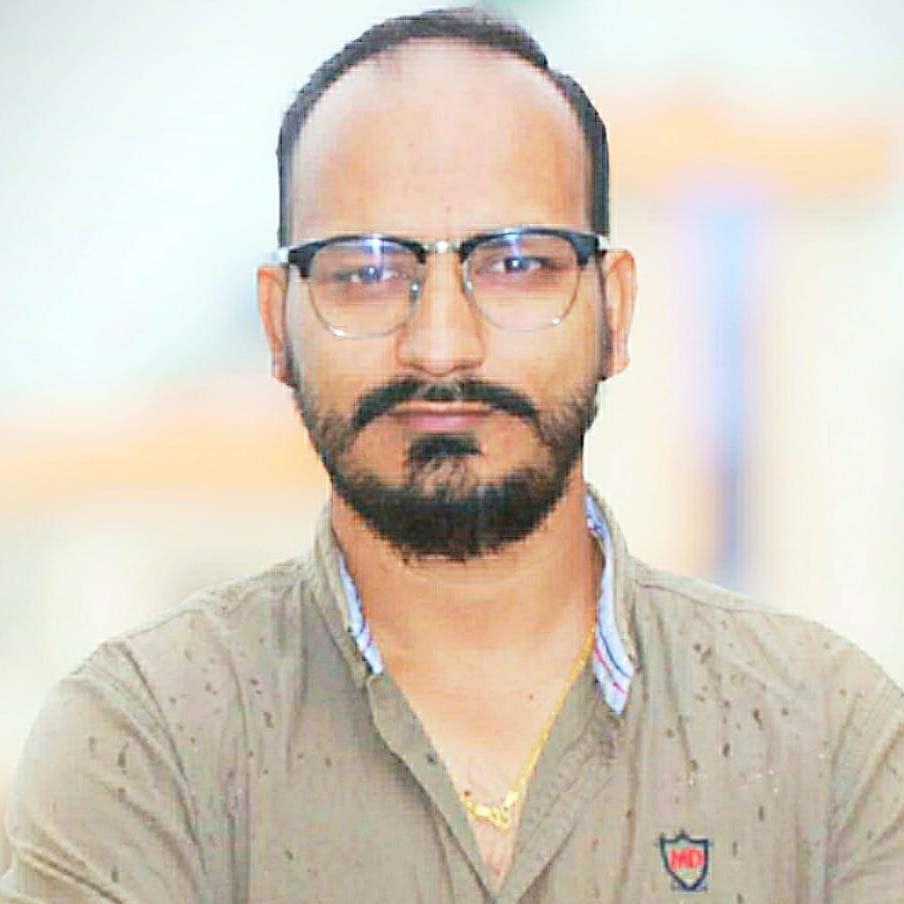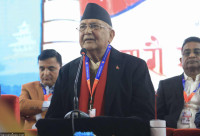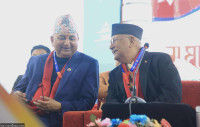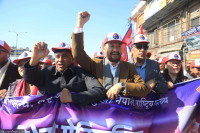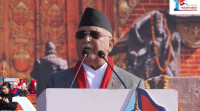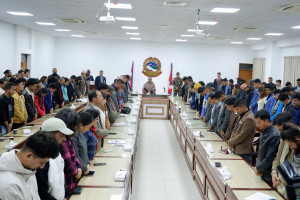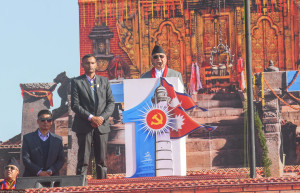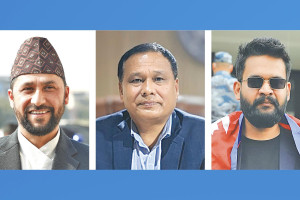Politics
National flag caught in politics. Experts call for clearer rules
Nepal flag has been widely and randomly used in various protests, campaigns and other events in recent years.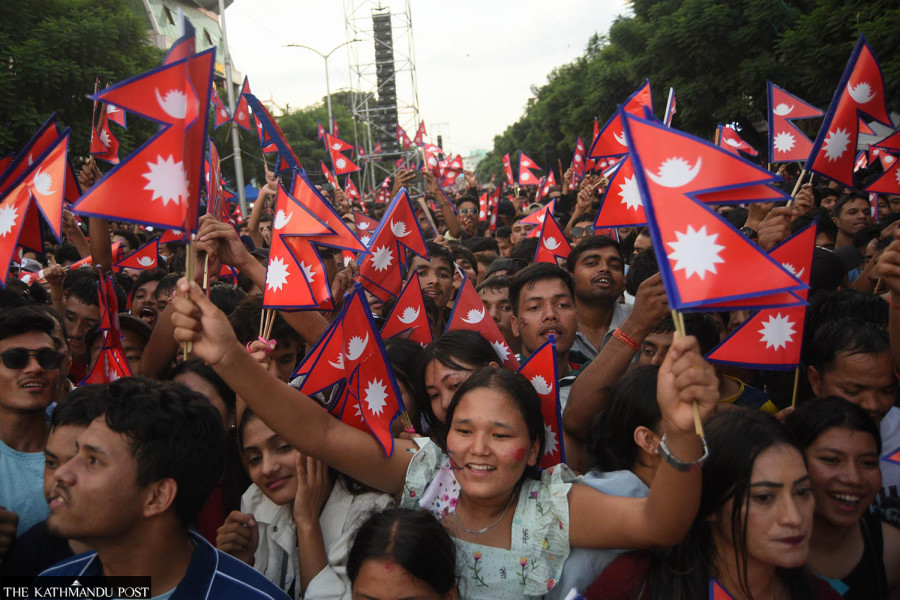
Purushottam Poudel
The rampant use of the national flag at political gatherings, protests, and various other events has emerged as a matter of concern for the government.
The issue has become tricky as the procedure on the use of the national flag does not explicitly state whether it can be used in events organised by political parties and other groups promoting their agenda.
Part 3, section 62 of the Procedure on the National Flag of Nepal-2012 specifies the procedures on the use of the national flag. Under the section titled “Prohibition on the use of the national flag,” it clearly states that the flag should only be used for hoisting purposes.
While the general public is not barred from using the flag, the procedure stresses that its dignity must be upheld at all times.
Despite these regulations, the flag has been rampantly and randomly used in various protests, campaigns and other events in recent times.
In many cases, the dignity and respect mandated by the procedure appear to have been disregarded during such events.
Although the procedure prohibits the national flag from being used for purposes other than hoisting, many protesters have been seen draping the flag around their bodies during demonstrations. This raises the question of whether the flag’s misuse is being increasingly normalised, especially when used as a tool to symbolise political stance of certain organisations.
The procedure does not explicitly clarify whether a political party is allowed to use the national flag for the events organised to promote partisan agendas. As a result, its use by political parties in organised protests has notably risen, raising concerns over the flag’s sanctity, experts say.
“As the national flag symbolises the country itself, people should be conscious while using it during political protests,” said Nilamber Acharya, former law minister. “It is better to organise political protests under the flags of respective parties.”
Recently, as misuse of the flag has escalated, the home ministry has also expressed its concern.
“Though the procedure of the national flag has not explicitly mentioned whether it could be used in political rallies, the home ministry will pay attention to it in the coming days in view of its increasing misuse” said Ramchandra Tiwari, the spokesperson of the home ministry.
It is a matter of pride when citizens use the national flag to commemorate significant events. Still, it should not be misused to serve political interests or for something that could raise questions over the flag’s dignity, Tiwari added.
As the country is witnessing more protests, the need for clearer guidelines and stricter enforcement to ensure the flag’s proper use has become pressing, observers said.
Without stricter oversight, the national flag could continue to be misused, undermining its role as a symbol of unity and pride for the Nepali people, they said.
On Monday, during a protest organised by the Rastriya Prajatantra Party-Nepal (RPP-Nepal) at Shantibatika, Ratnapark, participants were urged to attend carrying the national flag.
Also joining the protest were other pro-monarchy forces such as Rajendra Lingden’s Rastriya Prajatantra Party (RPP), Nabaraj Subedi’s Joint People’s Movement, and Keshar Bahadur Bista’s Rastriya Shakti Nepal.
The RPP-Nepal organised the demonstration to demand immediate release of RPP leaders, including the party’s senior vice-chair Rabindra Mishra, among others who were arrested during the pro-monarchy protest at Tinkune on March 28. The party described those detained as prisoners of conscience and demanded that the government immediately halt the formulation of legislation that could restrict support for monarchy and opposition to secularism.
RPP leader Mishra and controversial businessperson Durga Prasai, who was designated as the ‘field commander’ of the March 28 protest were arrested on charges of inciting the protesters at the Tinkune protest. The event had been organised by the Joint People’s Movement formed to revive Hindu kingdom that was abolished in 2008.
Rajaram Bartaula, RPP-Nepal’s general secretary and spokesperson, said the party had encouraged participation of like-minded groups, organisations, and individuals.
“When patriotic people use the national flag to show their pride in the country, how can it be termed the flag’s misuse?” Bartaula asked.
This suggests that when an event has participants from competing political parties, the national flag can help bring them together.
Experts believe people should be allowed to hoist the national flag out of pride. However, it should also not be used for vested interests of some parties, says Umesh Mainali, former secretary of the Home Ministry.
“Using the national flag in a political gathering to attract people as they won’t otherwise take part under a political flag is a misuse of the national emblem,” Mainali said.
But for senior advocate Purna Man Shakya, as the national flag belongs to everyone, its use should not be very restricted.
“Even if a political party uses the national flag as a means to gather people for a protest, individuals who do not share the party’s views would choose to stay away, so it is wrong to argue that the national flag brought them together,” Shakya added.
But constitutional expert Chandrakanta Gyawali argues that the use of the national flag outside areas recognised by the state and authorised by the government would be unconstitutional.
“National flag represents the pride of the nation and there are specific protocols for its use,” Gyawali adds. “Therefore using the national flag without government permission is illegal. Its use in political parties’ events cannot be considered appropriate.”
On March 28, participants of the protest calling for the restoration of the Hindu kingdom and the abolition of the federal republic were carrying national flags. The demonstration escalated into violence, with participants involved in acts of arson, setting fire to private and government vehicles, vandalising media houses and party offices, and looting supermarkets.
Two individuals lost their lives, and 13 others required intensive medical treatment. Even the participants involved in arson, vandalism and looting were seen draped in the national flag.
The Joint People's Movement, led by Subedi, an 87-year-old Panchayat-era leader, was supported by monarchist parties including the Lingden-led RPP and Thapa’s RPP-Nepal.
The use of the national flag in political demonstrations is not limited to pro-monarchy parties. Following the arrest of Rabi Lamichhane, president of the Rastriya Swatantra Party, on October 18 for his role in the embezzlement of cooperative funds, his party held protests in both Pokhara and Kathmandu. During these protests, too, the national flag was used as a symbol of political resistance.
Various other groups also often use the national flag when they want greater public participation in events and campaigns.




 6.12°C Kathmandu
6.12°C Kathmandu